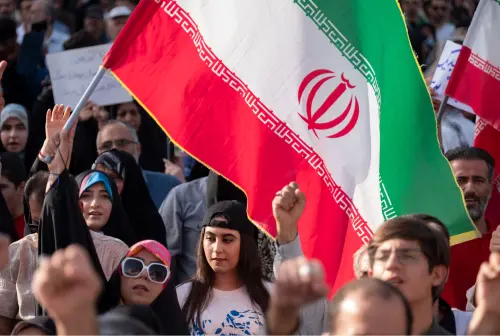This week, Condoleezza Rice is spending four days shuttling between Jerusalem and Ramallah. That’s the most time this secretary of state has ever spent in the Holy Land, and it’s a sign that Washington is gaining traction on the international peace conference it has planned for November.
This may be an administration that has mocked photo-op summits, but next month’s meeting in Annapolis, Maryland, should present quite a pretty picture. Not only will American, European, Chinese, Israeli and Palestinian leaders be there—so might representatives of as many as seven Arab states, including Saudi Arabia, that don’t recognize Israel.
That would be progress. But as the date approaches, pessimists are predicting yet another stalemate. Critics point to the mistrust between Israel and the Arabs, the weakness of Israeli Prime Minister Ehud Olmert and Palestinian President Mahmoud Abbas, the Hamas-Fatah split between Gaza and the West Bank, President George W. Bush’s lack of enthusiasm for peacemaking and Saudi skittishness. Moreover, the issues to be discussed—Jerusalem, refugees, settlements and borders—are extremely complex and politically sensitive. Failure to achieve a breakthrough, it’s feared, will hand Hamas and its Iranian backers a big PR victory. Some critics predict that the summit will fall apart before it begins—that the Bush administration will exclude Syria from the meeting, and that the Saudis will back out if the Syrians don’t come.
The parties involved, however, seem to be ignoring gloomy predictions; if anything, they’re showing a downright sunny disposition. Olmert and Abbas have been meeting privately for months now, and both report progress on the underlying issues. Peacemaking is in the air, and their poll standings are improving—even as Hamas’s are in decline.
There are other good signs. In September, Rice met in New York with the foreign ministers of the Arab countries Washington wants at the summit. Her Saudi counterpart said afterward that “finally the right approach to peace is being taken.” Even Amr Moussa, the reliably downbeat secretary-general of the Arab League, was positive about the prospects.
Rice also defied the pessimists by announcing on September 23 that the Syrians would indeed be invited. Damascus may yet exclude itself, but Syria has expressed repeated interest in negotiations with Israel, even after the recent Israeli airstrike on a rumored Syrian nuclear target. Syria now senses that change is afoot, and it doesn’t want to be left behind.
Even if everyone shows, critics insist that agreement will remain elusive. Yet no final deal is required to make the meeting a success. Olmert and Abbas have agreed that the purpose of the summit will be to launch and bless final peace negotiations, not conclude them. Simply restarting serious talks would be an achievement, since no formal peace discussions have been held for seven miserable years.
That blood-soaked recess seems to have made both sides more realistic. A majority of Israelis would relinquish the West Bank tomorrow if they believed that a responsible Palestinian partner would step up to exercise effective control there. During last week’s cabinet meeting, Olmert even allowed discussion of the once heretical idea of dividing Jerusalem by putting Arab suburbs under Palestinian rule. More remarkable still, the proposal drew support from Avigdor Lieberman, the leader of a right-wing Russian-immigrant party.
A majority of the Palestinian territories also now supports peace with Israel—even in Gaza, where Hamas holds sway. A sense of urgency seems to be concentrating the minds of Abbas and his Fatah comrades. They recognize that if they can’t show their people that the Fatah approach—negotiations with Israel—works, the West Bank could fall to Hamas just as Gaza did.
This normally absent sense of urgency is also at work in the larger Arab world. The leaders of Saudi Arabia, Jordan and Egypt understand that they, too, need to offer a credible alternative to the violent defiance of Hamas, Hizbullah and their Iranian sponsors. Rice and Olmert want to cement a virtual Arab-Israeli coalition to balance Iran’s bid for regional hegemony. Iran’s Sunni neighbors in the Gulf are similarly inclined, and resolving the Palestinian problem could provide the glue.
Of course, Hamas could still use violence to destroy the emerging harmony. Progress could also be undermined by the Palestinians’ inability to deliver on their commitments, by instability in Israel’s coalition government, or by a lack of support from a preoccupied Bush. Still, there’s one big reason for hope. For the first time in memory, all the would-be peacemakers find themselves in the same boat, dragged downstream by the powerful current of Iranian-backed extremism; and if they don’t find a way to paddle forward, they could well go over the falls together. It’s an existential fear. And it just might provide a powerful enough incentive to restart a meaningful Middle East peace process.
Indyk is the director of the Saban Center for Middle East Policy at the Brookings Institution and a former member of President Bill Clinton’s Middle East peace team.
The Brookings Institution is committed to quality, independence, and impact.
We are supported by a diverse array of funders. In line with our values and policies, each Brookings publication represents the sole views of its author(s).


Commentary
Optimism for Mideast Summit
October 22, 2007